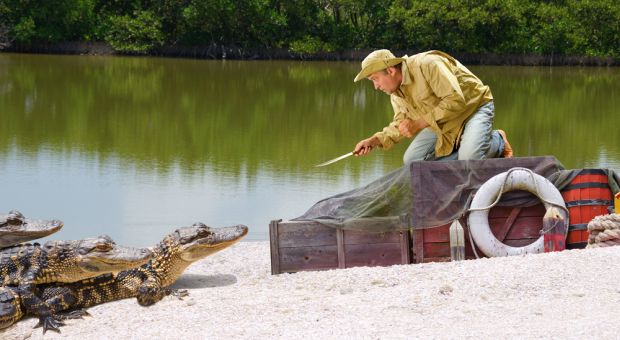To begin with, I find the premise of today’s article to be very disturbing.
I mean, being attacked by an animal, whether it’s a mugger on a dark alley, a crazed dog on a street, or a bear when you’re outdoors hiking or whatever, is a scenario no one would enjoy even contemplating, never mind finding himself/herself in. The good news is that these type of encounters are relatively rare, that if you’re not living in certain areas of New York, Chicago or Detroit. The same goes for wild creature attacks. Even if people getting mauled by wild bears or eaten alive by sharks make for sensational headlines used to scare innocent tourists year after year (if it bleeds, it leads, this is the golden rule in the yellow mainstream media), such events are incredibly rare in the real world.
The sad truth is that our fellow humans are way more dangerous for our personal security than wild animals. Just to give you an example, wolves kill 10 people annually, while “Jaws” (sharks that is) kills 6. Lions kill approximately 22 people a year, elephants and hypos about 500, and crocs around 1000. The most dangerous wild animal is the snake though, as no less than 100,000 people die every year killed by various species of snakes, both venomous and constrictors. If you are wondering what’s wrong with snakes (besides what the Bible teaches us), well, the simple answer is that they’re to be found all over the world, unlike tigers, hypos, sharks, lions or wolves. You probably have a snake (or more) living under your house or in your garden by the way, even if it’s not a venomous variety.
Wildlife Can Be Unpredictable
Even if there are only 10 people eaten by wolves every year, you don’t want to be part of that statistic (nor to get paranoid every time you’re hiking in the woods by the way). Always remember that any type of wild animal is highly unpredictable. Also, that stupidity kills.
As a fun factoid, there are tens of people dying annually in India, China and Africa due to selfies. I mean, people are so dumb, that they get (too) close to wild animals just to take a selfie and post it on social media. And I am talking getting in the close vicinity of elephants, crocodiles and other nasty critters. Getting too close to a snake, gorilla, elk or whatever just to take a cool picture and gather likes on Facebook is a very stupid idea in this writer’s opinion.
The general rule of thumb with regard to getting too close to an animal is that if it’s reacting to your presence, you’re too close. Some animals scrape their paws when they think you’re too close, other will put their ears back or even give you “verbal” clues. As my real estate agent used to say: everything in life is location, location, location, the same goes for surviving wild animal attacks. The first rule is to stay the hell away from them in the first place, i.e. to avoid the problem in the first place. Prevention is the mother of…you know the drill.
How to Prevent Attacks from Dangerous Animals
Since we’ve covered the “selfie” extravaganza, if you’re a camper or a hunter, you must know the area you’re cruising. Ask the park ranger or the locals about the probability of wild animal attacks in the area. The point is, you should do “recon” first and foremost, and be prepared for the worst case scenario, as in carry a gun for self defense, especially if there are known cases of wild animal attacks. Obviously, if that’s the case, the best thing to do would be to find yourself another hunting/camping/whatever spot. That if you’re the smart type.
Another thing to contemplate is the hugely popular “cleanliness is close to godliness” saying.
In this particular case, that would translate into “keep your camp clean”. Wild animals, especially (dangerous) carnivores are usually lured by food lying around one’s camp, if you catch my drift. Depending on where your camp is located, you might attract a bear, a coyote or a cougar, besides those cute deer or raccoons. Hence, the food must be kept in sealed containers at all times if it’s not consumed immediately. Food waste and garbage must be placed in plastic bags as far away from your camp as possible. The best thing to do would be to bury the waste. Food utensils must be properly washed, and the same goes for the clothes that were worn by the cook.
Moreover, try to resist the urge to feed cute and furry animals, like squirrels and such. Their presence might attract predators, you know. So, regardless how cute a deer or a rabbit may be, refrain from giving them cookies. They might get diabetes. Finally, never wander off alone (and especially if you’re not packing heat).
Surviving animal attacks
In my personal experience, getting attacked by a wild animal at some point in one’s life, especially if you live in a big and “diverse” city, is inevitable. That’s my philosophy, and that’s what I am preparing for every day. The same holds true for regular hikers, as in they’re aware of the fact that a wild animal attack is basically inevitable, just like death and taxes. Besides proper food management and knowing the behaviors/habits of predators in a given area, the “first rule of fight club” is that you must fight for your life. As in, stand your ground and/or don’t run away, and fight the animal like your life depends on it. Of course, that depends on the animal attacking you, but stick with me. I know, it sounds scary, but the alternative is worse. Depending on what type of animal is claiming your mortal flesh, you should employ a different strategy in each case.
How to survive a snake attack
Statistically speaking, a snake bite would be your most safe bet (100,000 deaths/year due to snake-bites is a respectable figure).
The first thing I would advise any hiker/outdoor-enthusiast would be to learn what species of deadly (as in poisonous) snakes can be found in a particular area. There are not many, believe me, as most species are not dangerous to humans, as in not poisonous. Another interesting factoid for my readers, which goes to stupidity being the mother of most deaths by snake-attack, is that 80 percent of people bitten by snakes were trying to catch the respective reptile as a trophy of sorts, or whatever. I kid you not. So, stay the hell away from snakes, okay? If you see a snake, go the other way ASAP, even if you’re “positive” it’s not dangerous. That’s the first rule of surviving a snake encounter.
Now, if a snake bits you in a Pearl-Harbor type of attack (by surprise), don’t try to “suck the blood out of the wound”, like “they” do it in the “movies”.
It doesn’t work, and if it’s somebody else sucking on your snake-bite wound, he/she might get killed/severely injured in the process. If you get snake bitten, according to Australian experts (and I tend to believe those Aussies, they know everything about snakes, spiders and other horrible creatures which inhabit their country), the best thing to do would be to keep your cool and use a compression bandage (not a tourniquet) wrapped 3-4 times around the snake-bite area, as soon as possible. Snake bites require specialized treatment, as in anti-venom serum and painkillers. Yes, you would require medical attention, soldier. The good news is that there’s anti-venom for basically any type of venomous snake. Keep that in mind when you go hiking.
Crocodiles and alligators
Since crocodiles/alligators are reptiles too, they make for the number-two man-killer in the world, after snakes.
Crocs have the strongest jaws on the planet, so forget about breaking free. If you’re lucky enough to get grabbed by a nasty crocodile/alligator, the best thing would be to shoot that thing in the head. If you’re not carrying, well, the joke’s on you. We have the second amendment for a reason.
However, you might still get a chance: hit the eyes or the throat, which are very sensitive areas for any animal, especially if you hit them with a knife, or something similar. If you don’t have anything to use against the eyes or the throat, put your faith in your fingers. Fight for your life, the croc will give you no quarter. If you see a crocodile/alligator sneaking up on you, run in a zig zag pattern, while shouting. Fortunately, you can outrun a croc if you’re not the 300 pounds type.
If you swim and you spot a crocodile, well, you’re a dumb person to begin with, as you swim in croc-infested waters, and there’s a law called natural selection. Social Darwinism aside, by all means, don’t create splashes and don’t shout. Try to be inconspicuous, and not draw attention to yourself; also, vacate the premises ASAP in “stealth mode”. Your chances to survive a crocodile attack in the water are slim (next to zero).
With reptile-attacks taken care of, now enter the statistically improbable but very mighty mammal.
Deadly Mammals
There are two species of mammals in North America that you can’t run away from, even if your name is Harley Davidson: the mountain lion and the black bear. If you see one of those far away, turn around and go back, especially if it did not see you. Try not to disturb it, mind your own business, keep your distance. Now, even if you see a bear close to you, remember that bear attacks on humans are very rare, hence stay calm and try to make yourself as bigger as you can: wave your arms, stand tall, even talk to the bear. Bears are curious creatures, it’s their nature, and they may come to take a closer look at you. That doesn’t mean they’re going to rip your head off. Not necessarily, I mean. So, stand your ground and try to back away slowly. If the bear goes after you, stop.
The general rule of thumb is to stand your ground, and look big/aggressive. Most bear attacks are bluff attacks. Now, if you’re next to a tree and you have that squirrel-gene, you may try to make a run for it, provided you can climb quickly at least thirty feet. Remember that running from a bear would trigger an instinctive reaction to chase you, as in you’ll be regarded as “prey” by default.
Finally, if everything else fails, there’s that old “play dead” trick, when you are supposed to curl up in a ball and lie silent and still, thus surprising the bear and making him regard you as a non threat. However, standing your ground, fighting back and playing the aggressive card should be your first reaction.
As far as mountain lions go, they usually prey on deer and elk, not you, hence attacks on humans are extremely rare.
Keep in mind that peak cougar activity takes place at dawn or dusk. Even if cougars are generally shy and stay away from humans by default, in the eventuality of a close encounter, apply the same philosophy described above with the bears, i.e. stand your ground (don’t run away), raise your voice/shout, make yourself to appear as big as possible, don’t back down and try to intimidate the critter. Running usually triggers that “seek and destroy” instinct in all predators. There are people who successfully fought back cougars and bears using sticks and stones as a desperate measure. But I must emphasize the obvious advantages of carrying a gun when out in the wild. Moreover, the same “stand your ground, be loud/appear big and fight for your life until the end” strategy also applies with bear/coyote attacks, which unfortunately tend to attack in packs, which is a whole different matter, especially if you’re alone and unarmed.
Shark attacks
Yes, shark attacks are extremely rare, and to survive one, you should try not to panic (it’s very easy to say this from your laptop, I know), and not to draw its attention. Playing dead may work, as sharks are programmed (by the way, sharks are pretty dumb) to attack live/moving targets, not immobile ones. In case you have to fight for your life, remember that eyes and gills are vulnerable, while some folks make a good case for punching sharks in the nose to sent them packing. And yes, fight for your life by any means necessary, fight to the end. Try to make the shark realize it’s not worth the effort to eat you. You might have a chance. Anyway, swimming in shark infested waters is very stupid, as I already told you in the crocs section. If you don’t hold this to be true, at least keep in mind that sharks are attracted to blood (hence never swim while bleeding), contrasting/bright colors and shiny objects (like jewelry, watches).
Massive animals
As far as elephants, rhinoceros and hypos go, even if some may argue they’re friendly and clever animals (especially the former), I would strongly advise you to keep a healthy (at least one mile) distance from such creatures. Or, don’t go to safaris at all, you’ll live longer.
Getting back to North America, elk and bison attacks are known to occur from time to time, but they’re easy to prevent by avoiding traveling during dawn or dusk, and keeping a safe distance at all times. Also, never approach a baby calf, as the maternal instinct is an evil bitch and moms tend to be over-protective, if you know what I mean. Bulls are aggressive during the rutting season, so keep that in mind while hiking.
Stay Away from Mothers with Cubs, Regardless of the Species
Even deer and/or raccoons may give you a run for your money, if you don’t keep your distance. Finally, try to never travel/hike/camp alone, always carry a weapon when out in the wild (and learn how to shoot), keep your camp free of food and thoroughly clean, do not feed wild animals, do not panic in case of an attack, try to find help ASAP, defend yourself by any means necessary in case of a wild-animal attack and always stay frosty.
I hope the article helped. If you have ideas or comments, feel free to comment in the dedicated section below. Stay safe.
























































































I can’t believe how screwed up some writings have become. This article, while interesting, mentions HYPOS at least three times (I assume you mean the subject of Gayla Peevy’s old Christmas song, HIPPOS). The term HYPO usually means a hypodermic needle.
And there is the reference to snake problems, “if a snake bits you.” an infantile form of poor writing.
Such escapees of good editing tend to make the advice value of the article to be reduced. Shame.
Cactus Bob…. You beat me to it. Don’t think I really would trust half of the crud this guys says. And he lays out a sense of arrogance in the article (if you can call it that) as well…..
When mention dangerous mammals, the writer mentioned black bears, but not the brown bear. In the western part of the country these are prevalent. The way you should act if you see a brown bear is different than if you see a black bear.
The writer’s grammar is of great concern as well. There are way too many instances where he has used phrases, yet written them as if they are complete sentences. It might be a good time for the writer to go back to school.
More people are killed by hippos than crocs.
You can survive any wilderness or jungle by following the BRFJS procedure (Basic Rule For Jungle Survival)
1. NEVER EVER go into the jungle at night,
2. NEVER EVER go into the jungle in the daytime.
Nice article but, fortunately N/A for most of us who are smart enough not to venture into the predator’s back yard. BTW, it’s venomous snakes, not poisonous, LOL! Bear spray (which is 5X more potent than the key chain ones ) shoots ~6 yards and will stop most bears or other 4-legged predators. My brother and I saw a puma walk right by the edge of our camp while backpacking in Mt. San Jacinto at 9,700 feet elevation. I do agree that humans are far more of a threat and often have evil intentions. Good idea to be armed while hiking, camping or backpacking.